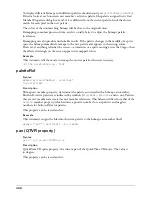
455
The origin point can be set with floating-point precision using the separate
originH
and
originV
properties, or it can be set with integer precision using the single
originPoint
property.
You can set the
originV
property only if the
originMode
property is set to
#point
.
This property can be tested and set. The default value is 0.
Note:
This property must be set to the default value if the scaleMode property is set to #autoSize, or the sprite does
not display correctly.
Example
This sprite script uses the
originMode
property to set up a Flash movie sprite so its origin point
can be set to a specific point. It then sets the horizontal and vertical origin points.
on beginSprite me
sprite(me.spriteNum).scaleMode = #showAll
sprite(me.spriteNum).originMode = #point
sprite(me.spriteNum).originH = 100
sprite(me.spriteNum).originV = 80
end
See also
originH
,
originPoint
,
scaleMode
otherwise
Syntax
otherwise
statement(s)
Description
Keyword; precedes instructions that Lingo performs when none of the earlier conditions in a
case
statement are met.
This keyword can be used to alert users of out-of-bound input or invalid type, and can be very
helpful in debugging during development.
Example
The following handler tests which key the user pressed most recently and responds accordingly:
•
If the user pressed A, B, or C, the movie performs the corresponding action following the
of
keyword.
•
If the user pressed any other key, the movie executes the statement that follows the
otherwise
keyword. In this case, the statement is a simple alert.
on keyDown
case (the key) of
"A": go to frame "Apple"
"B", "C":
puppetTransition 99
go to frame "Oranges"
otherwise:
alert "That is not a valid key."
end case
end keyDown
Содержание DIRECTOR MX-LINGO DICTIONARY
Страница 1: ...Lingo Dictionary Macromedia Director MX...
Страница 756: ...Index 756...
















































